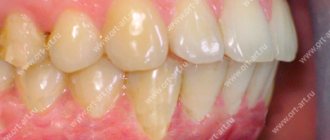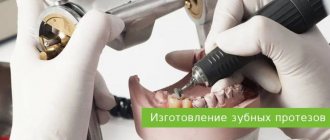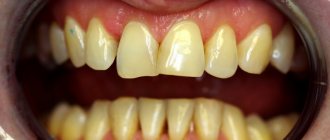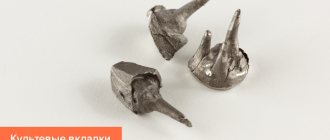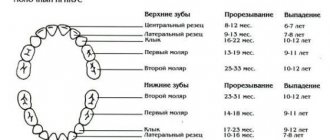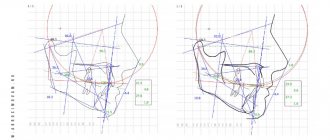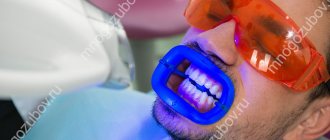Types of occlusion Indications for orthopedic treatment In case of deep bite In case of open bite In case of cross bite In case of small defects Implantation
The position of teeth with closed jaws in dentistry is called occlusion. Unfortunately, not every one of us can boast of perfectly straight teeth. Most people experience malocclusion. Most often, they are small and few people notice them, but there are situations when the malocclusion is pronounced and causes a lot of inconvenience. In these cases, it is customary to install braces. What to do if for some reason it is impossible to install braces? Dentistry has developed methods for correcting malocclusion using prosthetics, but doctors warn that they can only be used in specific clinical cases, strictly according to indications.
How is the bite formed?
The process of bite formation is long - from birth to adolescence. There are 5 periods.
- Initial (up to 6 months): no teeth, the upper jaw is larger in size than the lower jaw. At this time, an active feeding process is extremely important for the proper development of the jaw apparatus.
- Emerging temporary bite (6 months - 3 years): baby teeth and a bite appear, but it is still temporary. This stage is accompanied by inflammation of the gums, a rise in temperature, often grinding of teeth (bruxism), and emerging teeth may be crooked. It is important to maintain hygiene without taking any orthodontic measures.
- Formed temporary occlusion (3 - 6 years): baby teeth have erupted and can close in different ways, jaw growth continues. This is the time of active use of teeth. Characteristic wear of temporary teeth is considered normal before the upcoming change.
- Changeable dentition (6-12 years): jaw growth, loss of baby teeth and appearance of permanent teeth. Often new teeth, especially the lower ones, erupt unevenly. During this period, it is necessary to decide on a plan for further correction of the bite.
- Permanent dentition (12 - 15 years): replacement of milk teeth with permanent ones, all 28 teeth are visible, no wisdom teeth. The period is most favorable for orthodontic treatment.
In order for the bite to form correctly, there must be careful attention to teething, oral hygiene, and a timely plan to correct emerging problems.
Materials and methods
CEREC Omnicam, Trilux Forte Vita ceramic blocks, Duo Cement Kit.
Clinical case
Smile design, a virtual articulator and the ability to virtually mark tooth contacts make total bite reconstruction an exciting task
The patient complained of abrasion of the teeth of the upper jaw and, accordingly, a decrease in the height of the upper incisors to such an extent that they were no longer visible when smiling. As a result of a clinical examination of the maxillofacial area, no muscular-fascial tension was detected, the movements of the lower jaw were full, symmetrical, and no pathological changes in the TMJ joint were detected. The bite is straight (Fig. 1). On the frontal teeth of the upper jaw 13-23, occlusal abrasion facets and wedge-shaped defects in the area of 24 and 25 teeth are determined (Fig. 1, 2). It was not planned to change the height of the lower teeth, although they also had occlusal abrasion facets, but with a slight loss of tissue (Fig. 3, 15), so the bite increased without transversal and sagittal movements of the lower jaw, namely, in the usual occlusion only due to an increase height of the upper teeth.
Rice. 1.
Rice. 2.
Rice. 3.
Treatment plan
Total prosthetics and increased bite by increasing the height of the teeth in the upper jaw. The first visit includes the manufacture and fixation of ceramic restorations for 9 teeth in the upper jaw. In subsequent appointments, it was planned to complete the prosthetics of the remaining teeth, and in fact it took the following two visits: on the second visit - 11 teeth, 3 teeth of the upper jaw: 15, 16, 27 - and 7 teeth of the lower jaw: 44-31 and 34-36. On the third visit - the remaining two teeth of the lower jaw, 32 and 33.
Correct teeth bite
An ideal orthognathic bite implies the presence of the following features:
- The upper dental arch is slightly inclined forward and has the shape of a semi-ellipse, the lower, in the shape of a parabola, is slightly backward.
- When the jaws close, each upper tooth contacts the opposite tooth below.
- There are no obvious gaps between the teeth.
- The upper teeth overlap the lower teeth by about a third of their height.
Despite the fact that there are the above parameters for a perfect smile, the question “What should be the bite of the teeth?” cannot be answered unambiguously. In addition to the orthognathic bite, modern orthodontics allows for several options for the normal structure of the dentition and the location of the jaws.
Orthognathic
The upper row of teeth overlaps the lower one by 30% of the height, there are no gaps between the teeth or spaces between the rows.
Biprognathic
The dentition is slightly directed towards the vestibule of the mouth.
Progenic
The lower jaw moves forward slightly.
Straight
When the jaws close, the upper teeth come into contact with the lower cutting edges.
Partial or complete orthodontic treatment?
We offer different options. Sometimes full orthodontic treatment is necessary for an aesthetic and functional result. If we are talking about patients who already have quite a lot of orthopedic structures on the upper jaw, there are no lateral teeth, there is crowding, a close position of the front incisors on the lower jaw, then it will be sufficient to align the lower incisors and, as far as possible, raise the bite. In this case, we are talking about partial orthodontic treatment, lasting not 1.5-2 years, but much faster.
Local problems, such as tilted eighth teeth in the absence of seventh or sixth teeth, are solved by the support of two miniscrews without the use of a brace system or by using small systems for the lateral group of teeth. This will also be partial orthodontic treatment.
Malocclusion of teeth
Look at your reflection in the mirror. If you notice an excessively protruding upper or lower lip, teeth that “overlap” each other, or gaps between the dentition when the jaws are closed, this is a clear reason to consult a specialist. Descriptions of dental anomalies and photographs of teeth with malocclusion pathologies are presented in the table below.
Distal (prognathic)
In a distal bite, the upper jaw is more developed than the lower jaw.
Mesial (medial)
With a mesial bite, the lower jaw is pushed forward.
Cross
In a crossbite, the rows of teeth intersect in the manner of scissors when the jaws close.
Deep
In a deep bite, the upper teeth significantly overlap the lower teeth.
Open
The presence of pronounced gaps between the dentition when the jaws are closed indicates an open bite.
Symptoms
Signs indicating the formation of a deep bite:
- The upper jaw grows and develops more rapidly than the lower jaw, surpassing it in parameters;
- The lower lip is too thin (in most cases!) and can be turned outward;
- Reduced depth of the gap located in front between the lips and cheeks;
- Lack of space between rows of teeth;
- Unnaturally small chin size.
Patients with a deep bite usually complain of difficulty biting and chewing foods, distorted pronunciation of certain sounds, and difficulty breathing.
Classification
Main types of deep bite:
| Name | Description | Peculiarities |
| Distal | The chin is reduced and slanted to the side, the face is shortened, the lower jaw is underdeveloped. When you smile, your teeth and part of your gums are visible. | Shapes:
|
| Neutral | It is not visually noticeable in either children or adults. The facial features are proportional. Accompanied by the formation of a supramental fold, in which the lower incisors overlap the upper ones. The chin is proportional to the rest of the face. | Affects the articulation of sounds and pronunciation. Only a specialist can determine a neutral deep bite. |
Consequences
A deep bite causes aesthetic discomfort and negatively affects the main function of the jaw – chewing. The mucous membranes are constantly injured, the front teeth are overloaded and bruxism (grinding) is formed.
Due to regular friction, tooth enamel wears down, which leads to increased sensitivity. A deep bite negatively affects the functioning of the maxillofacial joints, so treatment must begin as early as possible.
A long-term complication of the pathology is the gradual loosening of teeth and their loss already at 30-35 years of age. A deep bite provokes the development of many diseases - periodontitis, gingivitis and interdental gaps.
Photos before and after treatment
Diagnostics
To identify a defect and make a correct diagnosis, the orthodontist carefully examines the oral cavity and receives complaints from the patient. In order to recreate the exact contact of the dentition, casts are made from alginate mass. For a more detailed assessment of the condition of the oral cavity, computed tomography (CT), electromyography and orthopantomography are used.
Attention! Sometimes a specialist uses photographs of a person’s face taken from several angles to identify the occlusal relationships of the dentition.
Treatment
Correction of deep bites is recommended in childhood, but the necessary dental care is also provided to adult patients. The selection of treatment methods takes into account the form and degree of the anomaly:
- Plastic surgery for frenulum correction. The techniques used are frenectomy or frenulotomy. Laser exposure can be used;
- Bracket systems. They are able to correct the bite when the position of the incisors and molars is fully formed. Vestibular and lingual structures are used for treatment;
- Veneers, crowns. A cosmetic method that masks a deep bite, BUT does not eliminate the causes of its occurrence;
- Osteotomy. A surgical intervention that involves separating the palate and upper jaw from the bones and fixing them with plates and screws.
Attention! Elimination of malocclusion before the age of 6 years is recommended with the use of removable vestibular plates and retainers.
Treatment of a deep bite is accompanied by wearing a special plate and performing muscle gymnastics exercises.
At home
Self-treatment of deep bite is IMPOSSIBLE. However, at home you can speed up the healing process with the help of migymnastics. Provided that the exercises are performed correctly and regularly, it allows you to achieve excellent results.
When performing exercises, follow several rules:
- use all areas of the oral cavity,
- maintain the greatest amplitude of execution,
- take a break after each exercise,
- Perform exercises until your muscles feel slightly tired.
Prevention of functional disorders
A deep bite cannot be eliminated in 1-2 days; treatment with braces can take years. Simple preventive measures will help prevent functional disorders.
Among them:
- elimination of caries,
- correction of incorrect posture,
- eating solid foods (nuts, carrots),
- exclusion of pathologies of the skeletal system,
- prevention of somatic and chronic diseases.
The key to oral health is regular dental examinations (at least 2 times annually).
Patient reviews
“I wore braces for a long time - as a result, the bite improved a little, but still caused discomfort. To permanently solve the problem, the dentist suggested surgery. I had it performed under general anesthesia, the swelling subsided in just a few days, and 16 days after the operation I went back to work! Finally, my smile doesn’t give me any complexes, and eating food doesn’t cause any inconvenience!”
Lyudmila, 28 years old, Samara.
“After installing the braces system, I experienced severe pain for several days and could not even eat. The dentist warned about such consequences, so I bought painkillers in advance. After about a week I was completely accustomed to the braces. Now I’ve been wearing them for 6 months and the improvement in my facial proportions is already noticeable!”
Anastasia, 21 years old, Saratov.
“A deep bite has tormented me since childhood, but 2 years ago I finally decided to correct it and turned to an orthodontist. Initially, it was corrected with braces, but the doctor warned that it would be impossible to do without surgical intervention. Now my bite has been completely restored (after braces and surgery), even the oval of my face has visually stretched. For prevention, I continue to perform myogymnastics. I'm happy with the result."
Alexey, 34 years old, St. Petersburg.
Bite in the absence of teeth
A person without teeth has problems with the functioning of the temporomandibular joints, facial aesthetics deteriorate, and wrinkles appear due to loss of skin tone. To avoid unpleasant consequences, it is necessary to restore the bite using a complete denture made using a special technique.
Bite restoration with complete dentures
- The central ratio of the jaws is determined - the position of the lower jaw in relation to the upper in three planes: vertical, sagittal and transversal. The role of the dentition is played by wax rollers.
- Measurements are taken using a device consisting of an external facebow-ruler and an intraoral plate with a flat frontal part and curved distal parts.
- The plaster model marks the boundaries of the future structure, the line of the middle of the alveolar process, the tubercles of the upper and lower jaw, and the midline.
- Artificial teeth are placed in such a way that when you smile, the part of the prosthesis that imitates the gum is not visible.
What is overbite
Bite
is the arrangement of the teeth of the upper and lower rows relative to each other when the jaws are freely closed.
Usually, to make a clear diagnosis, the orthodontist talks about correct and incorrect bite. But in fact, the bite has many varieties and only the primary classification includes:
- physiological – natural, correct, in which the chewing function is carried out without obstacles;
- pathological - changed under the influence of any factors, incorrect, interfering with the full functioning of the jaw.
According to statistics, more than 80% of people have some kind of disorder in the structure of the jaw, a significant part of which affects health and appearance. But the good news is that modern orthodontics is capable of correcting almost all dental malocclusion pathologies with early consultation with a specialist.
Bite after wisdom tooth removal
Some doctors are convinced that wisdom teeth are an atavism and must be gotten rid of. In ancient times, they were used to chew tough foods, such as raw meat. With the development of civilization, the human diet changed, his jaw began to gradually decrease - and the “eights” turned out to be superfluous. Most often, before starting to correct the bite, wisdom teeth are removed. This frees up space for the correct formation of rows, and the result of teeth alignment will be much better.
Basis of construction
Determining the height of the bite is based on assessing the distance between the jaws when fully closed, which makes it possible to determine the correct development and location of the elements of the dentition. The presence of defects leads to a displacement of the main anatomical components of the jaw region - the lips recede, the facial folds increase, the chin protrudes, and the height of the lower part of the face decreases. Increasing the height of the bite restores aesthetics and facilitates further therapeutic measures.
What affects the bite of teeth?
The negative impact of defects in the dental system on the condition of the entire organism has been repeatedly proven by scientists. The list of identified health risks is impressive even for ardent optimists.
- Due to improper distribution of the chewing load, tooth enamel wears off faster, teeth begin to react painfully to cold and hot, their necks become exposed, and noticeable gaps form between the teeth.
- Diseases of the temporomandibular joints occur, accompanied by headaches and a characteristic clicking sound when the jaws move.
- The aesthetics of the face suffers: its proportions change, wrinkles form, teeth become crooked, and the smile becomes unattractive.
- It becomes difficult to bite food, chewing functions are disrupted, causing diseases of the gastrointestinal tract.
- Speech defects appear, facial expressions are distorted, and self-esteem decreases.
- Crowding and crooked teeth cause accelerated tooth decay due to frequent chipping and carious lesions.
- The oral mucosa is injured - cheeks, gums, tongue, and the tissues of the oral cavity become inflamed.
- The quality of breathing deteriorates, which leads to diseases of the nasopharynx, trachea, and hearing aid.
All about sagittal gap bite
All people have a gap of 2-3 mm between their upper and lower teeth, thanks to which the cutting surfaces easily close and the enamel is not scratched.
When this gap is too wide, the face takes on an unnatural expression; when speaking, he whistles or has a lisp. Both problems are fixable. Find out how to treat a deep bite with a sagittal gap in our article. Causes of the problem
Sometimes the distance between the top and bottom rows is unusually wide or, conversely, narrow. Both are dealt with in a clinic with a good reputation. Problems with this gap begin for the following reasons:
- caries;
- fractures and dislocations;
- tumor processes in the mouth - true benign tumors, cancer;
- congenital malocclusions;
- the patient was treated by an inexperienced specialist who aggravated the disease - the work of such doctors is sometimes corrected for the rest of his life.
The consequences of non-physiological interdental space are facial asymmetry and deterioration of diction.
What is an abnormal bite?
Dentists use the concept of occlusion. This is what they call the process of closing the cutting surfaces of the incisors and canines. When the closure is tight, the gap between the row units is small. If some disease has led to a change in occlusion, it increases or decreases. Let's look at common anomalies.
- "Crossroads". This is an uneven expansion of the space between the upper and lower incisors and canines. Due to such a defect, the face loses symmetry - this catches the eye and gives rise to complexes about one’s appearance.
- Increased closing depth. Sometimes the interdental distance expands to 8-10 mm. This happens when the lower jaw is underdeveloped.
- Lateral occlusion. The distance between units in a row increases on one side.
- Pathology due to illiterate use of the braces system. Before installing ligatures and arches, specialists pre-align the bone tissue. If this step is skipped, straightened teeth take up more space at the bottom than at the top, or vice versa.
- Mixed states. If the jaws close asymmetrically, the interdental spaces increase in different directions.
Incorrect occlusion always affects facial expressions. Often aesthetic troubles are combined with difficulty chewing, pathological abrasion of enamel and other conditions.
Diagnostics
To study the position of the jaws, dentists use the following methods:
- Teleradiogram. The patient is sent for an X-ray of the skull in the lateral projection. In such photographs, problems with the jaws and teeth are immediately visible.
- Making a plaster cast of the jaws. An impression is made to clarify the relative position of the dentition. The cast shows the dimensions, length and width of the rows, and the nuances of the closure of the incisors.
How to correct the problem
There is no single method of correction for this condition for everyone, since orthodontic defects are extremely diverse. We will talk about the most commonly used methods for correcting excessively large gaps between the incisors and canines.
- Filling carious cavities. Fillings are placed to correct the space between the upper and lower incisors.
- Installation of non-removable expanders. Fixed expanders are made for people whose upper jaw protrudes significantly above the lower jaw. Results are achieved after just two months of wearing the treatment device.
- Surgery. The doctor assesses the severity of the problem and, for example, removes excess row units and selects implants in return. A surgeon is consulted in extreme cases, when conservative methods have not helped get rid of the pathology.
- Wearing dentures. If the client agrees to wear the denture constantly, this measure will easily return the teeth to their physiological places.
- Combination therapy. In 9 out of 10 cases, orthodontists try to combine methods for correcting dental occlusion. For example, fixed plates are selected for the client and braces are placed, or he is sent to a surgeon and customized prostheses are made.
Correcting mild malocclusion in the sagittal plane is not an easy task, the solution of which requires experienced doctors of various specializations.
Treatment errors
- Using one technique to correct the problem. For example, only the selection of braces. Braces are designed to provide alignment, but they do not correct the skeleton. Such constructions do not change the position or size of the jaws, so you should not trust orthodontists who promise to deal with this condition only with the help of “braces.”
- There is a distinction between “fours” and “fives”. In most cases, the gap increases due to problems with the skeleton, especially the back. If the patient’s defects are associated with a non-physiological location of the lateral teeth, they are moved back. And if the space between the incisors and canines has expanded due to poor posture or underdevelopment of the lower jaw, it should be developed and extended.
- Osteotomy without a thorough examination. Not all doctors know how to deal with the problem without braces. Therefore, clients often go to surgeons without trying to correct their condition with an orthodontist. For the conservative treatment of this problem, splints, mouthguards, splints and other devices for round-the-clock wear are used. These devices are not removed even while eating in order to quickly see the result and stabilize it. Specialists prescribe both removable and non-removable plates with screws to clients, depending on the situation.
- The client was not sent to correct his posture. Skeletal problems are directly related to the back muscles, vertebrae, and intervertebral discs. To stabilize the effect that was achieved after prescribing mouth guards and plates, competent specialists refer visitors to chiropractors. That is, before applying radical measures, you will need to work with an osteopath, chiropractor, exercise therapy instructor or kinesiologist.
What happens if you don't get treatment?
If the condition does not cause pain, there is a high risk of ignoring them in the hope of getting used to the problem. However, the consequences of unresolved orthodontic anomalies are quite dangerous:
- The molars will wear out quickly. When the teeth close too deeply, the molars are forced to cope with enormous stress. If you don’t go to the orthodontist, the enamel will be erased, multiple caries will begin, which will soon become complicated - that is, it will develop into pulpitis. Also, worn enamel becomes sensitive to the slightest touch, changes in temperature of water and food. While chewing, it causes sharp pain that is difficult to get rid of.
- The gums and mucous membranes suffer. There are many bacteria living in the mouth. If wounds form on soft tissues, pathogenic microorganisms enter them and lead to inflammation. Chronic inflammation of the gums is called periodontitis and is considered the main reason why young and middle-aged people are forced to install implants.
- Diseases of the temporomandibular joint develop, and the masticatory muscles suffer. When the joint does not work properly, the process of chewing food is disrupted. It becomes difficult for a person to chew, and over time, each meal begins to cause pain. This forces him to eat only pureed food, which is harmful to the gums.
- Speech defects appear. Incorrect relative position of the jaws entails unpleasant changes in appearance. Most often, the lower part of the face is shortened, the lips change position, and facial expressions change.
Problems with bones get worse over the years, and dealing with them becomes more expensive and difficult the longer a person avoids going to the clinic. All these troubles can be prevented if you find a competent specialist and select adequate methods of correction.
How long does therapy take?
If a person has too large interdental spaces, he needs to work on his problem with a doctor for at least a year. In children with a mild form of anomaly, the bite can become normal after six months of wearing orthodontic appliances. Adults sometimes have to patiently achieve the effect over several years.
Important. After completing orthodontic treatment, you must wear a retainer or a retaining plate. These products consolidate the results of therapy and help get rid of orthodontic problems forever. The retention period with conservative treatment lasts twice as long as the therapy itself. Some dentists believe that you will have to monitor the situation throughout your life.
Treatment of dental malocclusion
How to change the bite of teeth? Pathologies of the dental system can only be eliminated through orthodontic treatment. An exception is the correction of a low bite, when the height of the teeth decreases with age due to their wear. In such cases, the bite is corrected by dental prosthetics with crowns or veneers, as well as by implantation. Other anomalies of teeth and bite can be removed at any age with special orthodontic structures or through surgical intervention.
However, maxillofacial operations are performed only in case of serious deviations from the norm. Usually, to correct dental malocclusion, doctors suggest correction with braces or aligners.
Now that you know about all the health risks that can cause pathologies of the dental system, and how to correct your dental bite, all that remains is to take specific actions. Even if at first glance it seems that your teeth are straight, make an appointment with an orthodontist. Diagnosing the condition of the dentition will help maintain the health of other organs and systems. And timely orthodontic treatment will make your smile more attractive and significantly reduce the number of future visits to the dentist.
Correction of the smile zone and missing anterior incisors
There is an aesthetic problem in the smile area associated with the absence of front teeth, for example, second incisors. Nowadays, it is not uncommon that even their rudiments are missing. It does not cause complaints as long as there are baby teeth in this place, but after their removal the question arises about restoring the defect. In such situations, the orthodontist, orthopedist and implantologist choose a comprehensive treatment strategy. Options are being considered with implantation and prosthetics in this area or orthodontic movement of adjacent teeth with their further restoration with veneers to create a harmonious smile.
A less common situation is the absence of one of the front incisors. If the defect has existed for quite a long time, then problems may arise with implantation in this area due to a lack of bone tissue. Then the orthodontist proposes a treatment plan with moving the lateral incisor to the place of the missing central one, and prosthetics on the implant is carried out in the freed area where there is enough bone tissue.
Stage III - treatment and preparation of teeth for prosthetics
Before dental prosthetics, it is necessary to prepare the teeth so that they do not disturb the patient some time after the installation of expensive structures. To do this, Dial-Dent conducts a thorough diagnosis of the condition of previously treated canals and, if necessary, treats the canals of the teeth under a microscope, guaranteeing maximum service life of the teeth. To create a zone of attached gum, the surgeon performed periodontal manipulation. The hygienist performed gentle teeth cleaning and applied a special product to the front teeth to eliminate hypersensitivity. All these procedures were performed gradually, at a time convenient for the patient, while the dental implant was healing.
